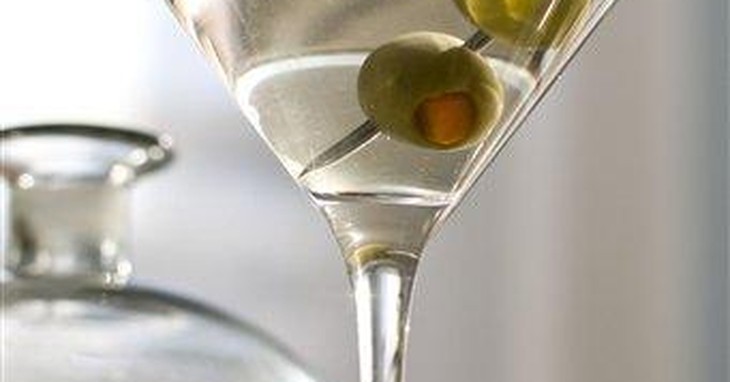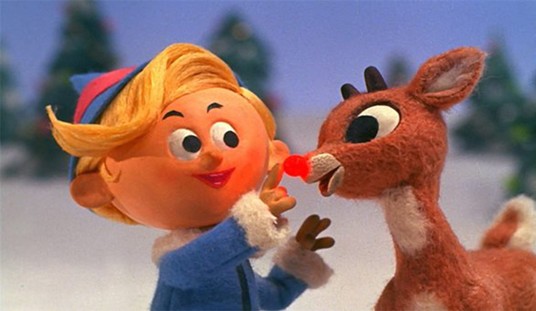(Because we know that man does not live by politics alone, but also by film, sports, booze, and barbecue, RedState writers are expanding their base of topics covered. “Dipsology: Beyond the Basics” is part of that effort as a RedState VIP exclusive. Click here to become a RedState VIP member and use code SLAGER for a sweet discount!)
When looking across the landscape of cocktails it cannot be argued — The Martini looms above all others. It is known, respected, revered, intimidating, and cinematic. It has become hotly debated when it need not be, and the name misappropriated when it should not be. While rules govern what it is, there are variables permitted as well; consider the crafting of the drink to have guardrails but with room to switch lanes as you see fit.
The lasting affection for the drink is seen in the fact that it seems to enjoy a repeated resurgence over the generations. Its emergence is around the mid-1800s, then it became cemented as a go-to with the codification of cocktails and bartending at the end of the century. The roaring ’20s established gin as a needed commodity and the drink was reestablished. The post-war boom of the ’50s to early ’60s brought a return to luxury (aided by a fictional secret agent), and then the 1980s brought a renewed appreciation of higher grade spirits, and the martini became the recipient of vastly improved ingredients.

Like so much of our potable histories, the Martini has inexact origins. The two most plausible back-stories are that it was a concoction brought about by the Martini & Rossi company to help move its Vermouth products, or the drink was evolved from the popular West Coast cocktail, The Martinez. The latter was a San Francisco-area creation that incorporated Gin with Sweet Vermouth, as well as Bitters and Maraschino.
The appeal of the Martini rests with numerous elements coming into play beyond merely having a drink. It is a potent bomb of an elixir that will deliver a strong physical reaction. But it is also a drink that is born of simplicity yet results in a high-class product. It carries a visual appeal as well, as the basic shape of the glassware conveys classic lines, its architecture lending to the clear fluid highlighting the garnish as the entire enterprise evokes luxury and refinement. Drinking a Martini is a sensory experience.
Concocting And Variations
While there are some purists who will dictate what is the “proper” Martini, the variables at play are more than permitted. Originally it was Gin that served as the primary ingredient, but Vodka became the accepted alternative. As for the secondary component — Dry Vermouth — this too has varying degrees of involvement and the debatable amounts of the ingredients defy the use of a militant stance to the creation. Then, when you have a variety of garnishes that can be employed, you begin to see the folly of the totalitarian approach.
That being said, many drinks which bear the word “martini”, or a truncated form of such, are not actually valid. A ”Gummy Bear Martini”, or the ”Apple-tini” are hardly in the same consideration. The temptation to use the classic glass as a serving vessel is understandable but hardly places these in the same class.
As for the recipe, you have to start with the size of your serving glass. While a martini on the rocks is acceptable it loses much of the allure; the stemmed conical bowl lends so much to the drink, including the garnish resting on an angle, or perched on the rim. I have a variety of Martini glasses which range in volume from 4 ounces up to 8, so the measurement is adjusted on the portion. This means the mixture is to be based on ratio, and this is up to the drinker’s preference.

Back in time, the general balance of the ingredients was a 3/1 mixture, Gin-Vodka/Vermouth. Over time the preference for a “dry” Martini developed, meaning a lesser amount of Vermouth against the liquor. This increase in the ratio has led to alternative preparation. Some might only dribble a portion of the Vermouth into the mix, others have merely drizzled a small dram on the side of the shaker glass before adding ice and spirit, to give only a hint of the flavoring. There is the in-and-out method, where the Vermouth is poured over the ice and then immediately strained off. Some resort to soaking cocktail stones in Vermouth, adding these to the shaker to deliver the faint amount of the product.
Then there is a debate on the mixing. Many will say that stirring is the only proper method, as shaking will cause too big of alteration of the spirits; “bruising” the Vodka or Gin is the result, we are told. This is the claimed effect of both aerating the liquor as well as overly diluting it. I have never encountered a time when someone could actually tell me that this effect has actually been the result. Your primary difference between the techniques is temperature, which itself can alter the effect on the palate. If this is truly a concern, solutions might range from storing the liquor in the freezer, or shaking with plastic ice blocks or stored cocktail stones — but honestly, the concern is overhyped.
The final component is the garnish. Olives constitute the most traditional option, the sharpness of the flavor serving as a contrast to the botanicals in Gin, or serving as the primary flavor if Vodka is the choice. A “dirty” version involves adding some of the olive brine to the mix, and there are even choices to be had with this element. You can get olives made specifically for the cocktail, stuffed with everything from pimentos, peppers, blue cheese, garlic, or more. The olives can also be your Vermouth delivery vehicle, as those marinated in the product are sometimes used.
Ardents will insist olives are the only acceptable choice for a true martini, but if you are like me, repelled by the taste of olives, then there are options. Cocktail onions are a selection, leading to it becoming called a Gibson. Citrus twists are also a common choice, but not cut wedges. A strip of peel is used and when twisted over the drink the citrus oils are released, forming a slick on the surface of the fluid. (My preference is a dry Gin Martini made with Bombay Sapphire, and a Key Lime twist.) Some others have seen a martini strained over a raw oyster, and there is even a Squid Ink Martini with a small tentacle applied as the garnish, but really by this stage you are trying way too hard.
Again, the methods and mixes are to be based on your preferences, so do not feel the need to adhere to the standards of others if you are not enjoying the result.

The Spook And His Spirit
With the arrival of James Bond in the early ’60s, the Martini became re-enshrined as a cultural item. The British spy became directly entwined with the drink, but I feel as if there was a slight error in the process. Bond famously quips on his preferred preparation, ordering his drink and then turning his gaze upon a woman as he calmly commands, “Shaken, not stirred.” But as a metaphor, he would have been served better dramatically to reverse that order; letting the fatale know that he has been stirred by her appearanc, but not shaken by her, would have been a smoother delivery.
Not only has the spy been associated with the famed cocktail, but he has also reflected a dichotomy with preferences. In the books, Bond has ordered his Martini with vodka 19 times, and with Gin 16 times. So what is the “Official” vodka of James Bond? That is something of a moving target.

Throughout the early films, Smirnoff appears on screen as the primary choice, but in later titles, he has been seen with Stolichnaya (he is slipped a Mickey made from Stoli in “The Living Daylights”). In “Skyfall,” he orders a Grey Goose at the casino. Finlandia was the branded partner in Pierce Brosnan’s last appearance as the spy in “Die Another Day,” and Currently, Belvedere Vodka stands as the branded tie-in spirit with the series since “Spectre.” Bottles of the vodka were sold with the artwork from the film, upon its release.
In truth, the Martini has been entwined with Bond from the very beginning, except in a unique fashion. Writer Ian Fleming, in the first Bond novel Casino Royale, had his soon-to-be super spy ordering what he called a Vesper. This was a drink of Fleming’s invention, named after a female antagonist in the book. It is a mix sure to confound the Martini militants in that it is made with both Gin and Vodka. The wildcard here is Vermouth is supplanted with Kina Lillet, and this too is a vexing addition, as that product has been renamed, and its recipe altered over time.
Fleming, as Bond, is kind enough to walk us through the creation, as he has his secret agent giving the bartender instructions: “Three measures of Gordon’s, one of vodka, half a measure of Kina Lillet. Shake it very well until it’s ice-cold, then add a large thin slice of lemon peel. Got it?” He then stipulates the Vodka should be of Russian or Polish origin. The modern version of Lillet is an acceptable, and inevitable selection.
The Vesper
- 3oz. Gin
- 1oz. Vodka
- 1/2 oz. Lillet
- In a shaker fill with ice, add the ingredients and stir/shake, until very cold. Strain into a chilled Martini glass. Twist lemon peel over the mix, run across the rim and deposit in the drink.
BONUS COCKTAIL
This weekend sees the running of the 146th Preakness Stakes, and there is an official cocktail! Well…sort of. There is at least an official name for one.
Named after the state flower that comprises the bouquet draped over the winner, the Black-Eyed Susan has been the official cocktail since the early 1970s. At issue is the recipe has frequently shifted, while maintaining a similar appearance. There have been adjustments for popular taste — and more likely for changing liquor sponsors.
This year shows the latest recipe, and it is a curious choice, so past variations will also be provided. The current recipe is more designed for corporate synergy than drinkability — Not coincidently Makers Mark, DeKuyper, and Effen Vodka are all sponsors.
2021 Black-Eyed Susan
- 1oz. Maker’s Mark Bourbon
- 1oz. Effen Vodka
- 1oz. DeKuyper Peach Scnapps
- 2oz. Orange Juice
- 2oz. Sour Mix
- Combine ingredients in a shaker with ice, shake well, pour into a Collins glass. Garnish with an orange wheel and cherry.
The Original Black-Eyed Susan
- 1 shot (1.5oz) White Rum
- 1 shot Vodka
- Fill with equal parts Orange Juice, Pineapple Juice
- Combine ingredients in a shaker with ice, shake well, pour into a Collins glass. Garnish with an orange wheel and cherry.
For a newer spin seen a few years ago there is this pleasing variation:
- 1-½ shots Orange Vodka
- ½ shot St Germain (or other elderflower liqueur)
- Fill with equal parts OJ, Pineapple juice
- Shake, squeeze lime wedge, garnish with an orange slice and a cherry















